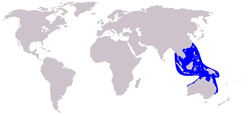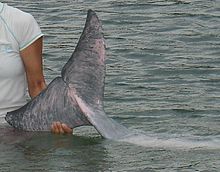- Chinese white dolphin
-
Not to be confused with the Baiji (Chinese River Dolphin).
Chinese white dolphin Conservation status Scientific classification 
Kingdom: Animalia Phylum: Chordata Class: Mammalia Order: Cetacea Family: Delphinidae Genus: Sousa Species: S. chinensis Subspecies: S. c. chinensis Trinomial name Sousa chinensis chinensis
(Osbeck, 1765)Chinese white dolphin range (blue area) The Chinese white dolphin (Indo-Pacific humpback dolphin, Sousa chinensis chinensis; Chinese: 中華白海豚; pinyin: Zhōnghuá bái hǎitún ) is a humpback dolphin species, one of eighty cetacean species. An adult is white or pink and may appear as an albino dolphin to some. Uniquely, the population along the Chinese coast has pink skin.[2] Pink skin is not pigment, but blood vessels for thermoregulation. The adult's body length is 200 - 350 centimetres and the infant's body about 1 meter. An adult weighs 150 to 230 kg. A Chinese white dolphin lives 40 years, which can be determined by teeth.
The Indo-Pacific dolphins are in Southeast Asia, and they breed from South Africa to Australia. There are two subspecies, with Sumatra, one of the Indonesian islands, as the dividing line between the Chinese and the Western subspecies, Sousa chinensis plumbea. The two subspecies differ in color and dorsal fin size. The subspecies found in Southeast Asia has pinkish white skin and a larger dorsal fin but lacks the fatty hump of South African and Australian relations.
At birth, the dolphins are black. They change to grey, then pinkish with spots when young. Adults are white.
Contents
Behavior
Chinese white dolphins swim to the water surface to breathe every twenty to thirty seconds and after that, they will dive into deep water again. A calf dolphin surfaces from the water twice as much as an adult. This is because calves have a smaller lung capacity than an adult dolphin. Adult dolphins can stay underwater for about two to eight minutes but a calf can only stay underwater for one to three minutes. Adult dolphins rarely stay under water for more than four minutes. They sometimes jump out of water,exposing their whole body. Besides jumping out of water, white dolphins also come up vertically out of the water, exposing the front half of their body. They have a pair of protruding eyes and they can see clearly in both air and water.
Reproductive cycle
Chinese white dolphins are sociable creatures and live in groups of three to four. Female white dolphins become mature at ten years old while the males become mature at thirteen years old. The Chinese white dolphins usually mate from the end of summer to autumn. Infant dolphins are usually born eleven months after the mating. Mature female white dolphins can give birth every three years and the parental care will last until their offspring can find food themselves.
ن==Dolphin watching== Hong Kong Dolphinwatch has been running boat trips to visit the Chinese white dolphins for the past twelve years. The dolphins mainly live in the waters of Lantau North, Southeast Lantau, the Soko Islands and Peng Chau. The trips run by Hong Kong Dolphinwatch are done primarily with the purpose of raising awareness amongst Hong Kong residents regarding the dolphins, and the operation strictly adheres to the Code of Conduct for Dolphin Watching Activities. Ten percent of the profits of the organization goes into research for Friends of the Earth (HK)'s Water Action Group, which is a charity aimed to raise public awareness of Hong Kong's coastal environment (see Environment of Hong Kong).
There have been some recent reports of dolphin watching practices that have further endangered the Chinese white dolphins. However, these generally are small thin and locally organised one-off tours or private pleasure boats that do not adhere to the Hong Kong Agricultural and Fisheries Department's voluntary Code of Conduct for Dolphin Watching Activities. The basic principles of these codes of conduct are: always observe the dolphins from a distance, and not attempting to physically contact, feed or harm the dolphins. Additionally, boats should maintain a slow and steady speed, not exceeding 10 knots; and the boat should always maintain a parallel movement to the dolphin's course.[3]
Origin of a Cantonese slang expression
The Cantonese has a slang expression "Wu Gei Bak Gei" (often written as 烏忌白忌, lit. "black taboo white taboo") which means someone being a bad omen or a nuisance etc. The phrase originates from the Cantonese fisher people, because they claim that the dolphins eat the fish in their nets.
However, in proper Chinese, it should be written as 烏鱀白鱀, with the "Gei" originally in olden Chinese, means dolphins. The "Wu" referring to the finless porpoises, which are black, and the "bak", white, referring to Chinese river dolphins. These two species often interrupt and ruin the fishermen's catch. As years passed, because "dolphin" sounds the same as "bad luck", the meaning of the phrase changed. However, in Cantonese, the "wu" refers to the calves of Chinese white dolphin and "bak" refers to the adults. Note that river dolphins (Baiji) do not exist in Hong Kong. Nowadays, dolphins are not called "gei" anymore, but 海豚 (Hoi tuen), literally meaning "Sea pig".
Conservation
The Indo-Pacific humpback dolphin is listed on Appendix II[4] of the Convention on the Conservation of Migratory Species of Wild Animals (CMS). It is listed on Appendix II[4] as it has an unfavourable conservation status or would benefit significantly from international co-operation organised by tailored agreements.
The Indo-Pacific humpback dolphin is also covered by the Memorandum of Understanding for the Conservation of Cetaceans and Their Habitats in the Pacific Islands Region (Pacific Cetaceans MoU).
Timeline of main events
- 1637: The Chinese white dolphin was first discovered in Hong Kong by the adventurer Peter Mundy near the Pearl River. The species are attracted to the Pearl River Estuary because of its brackish waters.
- 1765: Pehr Osbeck gives the first scientific description of the species.[5]
- Late 1980s: Environmentalists started to pay attention to the Chinese white dolphin population.
- Early 1990: The Hong Kong public started to become aware of the Chinese white dolphin. This was due to the side effects of the construction of the Chek Lap Kok Airport. It was one of the world's largest single reclamation projects: the reclamation of nine square kilometers of the seabed near Northern Lantau, which was one of the major habitats of the dolphins.
- Early 1993: Re-evaluation of the environmental effects of the construction of Chek Lap Kok Airport. This alerted eco-activists such as those from the World Wide Fund for Nature in Hong Kong, in turn bringing media attention on the matter. Soon enough, the Hong Kong Government began getting involved by funding projects to research on the Chinese white dolphins
- Late 1993: The Agriculture, Fisheries and Conservation Department was founded.
- 1996: Dr. Thomas Jefferson began to conduct research on the Chinese white dolphins in hope of discovering more about them.
- 1997: The Chinese white dolphin became the official mascot of the 1997 sovereignty changing ceremonies in Hong Kong.
- 1998: The research results of Dr. Thomas Jefferson was published in "Wildlife Monographs".
- 1998: The Hong Kong Dolphinwatch was organized and began to run dolphin watching tours for the general public to raise the public's awareness of the species.
- 2000: The Agriculture, Fisheries and Conservation Department started to conduct long-term observation of the Chinese white dolphins in Hong Kong.
- 2000: The population of Chinese white dolphins has reached around only 80-140 dolphins in the Pearl River waters.
See also
References
- ^ Reeves, R.R., Dalebout, M.L., Jefferson, T.A., Karczmarski, L., Laidre, K., O’Corry-Crowe, G., Rojas-Bracho, L., Secchi, E.R., Slooten, E., Smith, B.D., Wang, J.Y. & Zhou, K. (2008). Sousa chinensis. In: IUCN 2008. IUCN Red List of Threatened Species. Downloaded on 24 March 2009.
- ^ WWF Hong Kong
- ^ Code of Conduct for Dolphin Watching Activities, Hong Kong Agricultural and Fisheries Department
- ^ a b "Appendix II" of the Convention on the Conservation of Migratory Species of Wild Animals (CMS). As amended by the Conference of the Parties in 1985, 1988, 1991, 1994, 1997, 1999, 2002, 2005 and 2008. Effective: 5th March 2009.
- ^ Sharks and Whales (Carwardine et al. 2002), p. 362.
External links
- The Agriculture, Fishies and Conservation Department
- Hong Kong Dolphinwatch
- Hong Kong Dolphin Conservation Society
- Convention on Migratory Species page on the Indo-Pacific humpback dolphin
- Official webpage of the Memorandum of Understanding for the Conservation of Cetaceans and Their Habitats in the Pacific Islands Region
Categories:- IUCN Red List near threatened species
- Oceanic dolphins
- Fauna of the Indian Ocean
- Biota of Hong Kong
- Fauna of Taiwan
- Pearl River Delta
- Animals described in 1765
- Symbols of Hong Kong
Wikimedia Foundation. 2010.




